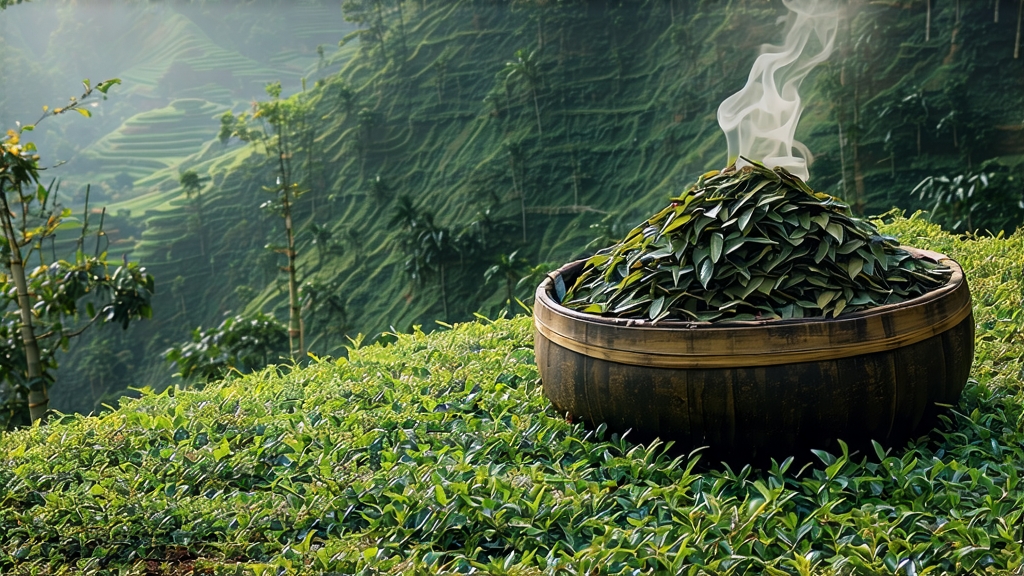
Liu Bao—literally “Six Forts”—owes its name not to the leaf itself but to the six strategic stockades that once guarded the trade route leaving Wuzhou, Guangxi. During the Qing dynasty, compressed dark teas from these hills were coolie-carried to the port at Guangzhou, then loaded onto junks bound for Southeast Asia. In the clattering holds, steam from the tropics met the still-fermenting bricks; by the time the cargo reached Kuala Lumpur or Singapore, the tea had darkened further, acquiring a mellow, medicinal sweetness that cooled bodies wilting under the equatorial sun. Thus Liu Bao became the first Chinese dark tea to develop an overseas identity long before Pu-erh stepped onto the world stage.
Unlike the Yunnan school that relies on the large-leaf Assamica variety, Liu Bao begins with a medium-leaf Camellia sinensis var. sinensis cultivar indigenous to the limestone karsts of Guangxi. Growers let the bushes climb to waist height on terraced slopes thinly veiled in red laterite; the stress of mineral-starved soil forces slow growth, concentrating polyphenols and fluorine that later translate into the tea’s signature throat-coating depth. Plucking takes place in late April, when three leaves and a bud have hardened just enough to survive the rigorous piling process yet still retain a vein of spring sap.
The craft protocol, codified in 1957 but orally transmitted for centuries, unfolds in six tightly timed stages: kill-green, rolling, first sun-dry, wet-piling, second sun-dry, and aging. The kill-green wok is heated to 280 °C for exactly 90 seconds; any shorter and grassy enzymes survive, any longer and the leaf caramelises into bitterness. After a quick knead to rupture cell walls, the tea is spread on bamboo mats under the subtropical sun until moisture drops to 18 %. Now comes the decisive step—wet piling. Workers spray 28 °C mountain water onto the leaf, heap it 70 cm high, and cover the mound with jute sacks and rice straw. Inside this compost-like core, temperature climbs to 55 °C within 36 hours, triggering a microbial riot dominated by Aspergillus niger, Blastobotrys adeninivorans, and a lactic acid consortium unique to Liu Bao. Every 48 hours the pile is turned, aerated, and re-moistened; after 10–15 cycles the leaf emerges the colour of rusted iron, exuding an aroma reminiscent of betel nut, damp bark, and fermented longan. A second sun-dry stabilises the tea at 12 % moisture, after which it is steamed soft, packed into 40 kg bamboo baskets lined with banana leaf, and stacked in riverside warehouses where humidity hovers at 85 %. There the tea will rest—ideally for seven years—while slow oxidation and continued microbial dialogue round off edges and deepen the bass notes.
The finished basket tea appears as dark chocolate-brown strips interlaced with golden tips. A snap of the leaf releases a perfume that confounds first-timers: hints of camphor, raw cacao, and something akin to petrichor after a summer storm. When brewed, the liquor ranges from burnt umber to deep garnet depending on age; surface tension is high, forming a glossy meniscus that reluctantly breaks under the breath.
To unlock Liu Bao’s layered personality, Gongfu approach is best. Pre-heat a 120 ml Yixing clay teapot with 100 °C water; clay rich in iron softens the tea’s resinous edge while amplifying its sweet return. Use 6 g of leaf—roughly two heaping tablespoons—rinsed for five seconds to awaken dormant spores. The first proper infusion, 10 seconds, yields a light sepia broth that tastes almost like pumpernickel crust. Subsequent steeps lengthen by five-second increments: infusion two brings forth jujube and molasses, infusion three introduces a cooling camphor note that lingers behind the molars, and by infusion six the cup is a silky, date-sweet nectar with the throaty echo of a fine old Cognac. A 20-year vintage can sustain twelve infusions before surrendering, the final pour still fragrant enough to perfume an entire room.
Western drinkers may prefer a single-cup method: 3 g